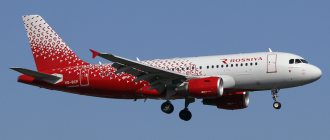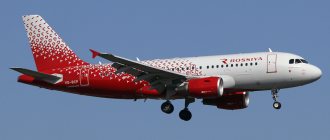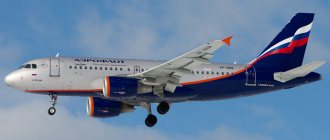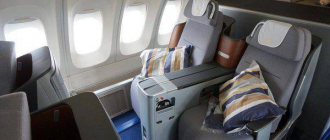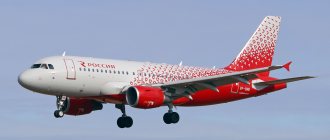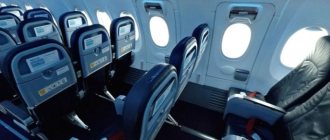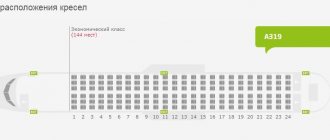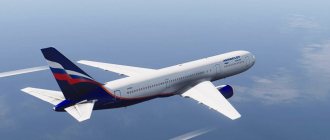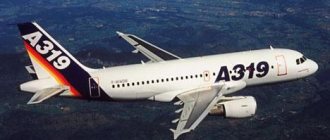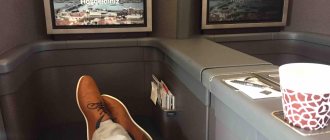AK Rossiya has 69 aircraft in its fleet. A third, 26 units - Airbus A319-100 aircraft. Quarter, 15 units - Boeing 737-800. Naturally, most of the company’s route network falls on these two types. And if the user’s trip begins with a flight with this company, it will be useful to know in which part of the plane the most comfortable seats will be. We'll look at the layout of the first one another time, but let's look at the Boeing interior layout in more detail.
Each liner has its own name
In 2016, the company supported the initiative of Rostelecom, which proposed that Aeroflot give its aircraft names of cities. So all 69 ships received proper names. On the Boeing 737-800, city coats of arms are placed on the nose under the cockpit, and the names are on the sides. The left one has a Russian name, the right one has an English name.
Summary table of correspondence between names and tail numbers
| Board number | Proper name | Serves in the company |
| First group | ||
| VQ-BJX | Astrakhan | 16 years |
| VQ-BSS | Barnaul | 11 years |
| VP-BOD | Belgorod | new |
| VP-BOB | Bryansk | new |
| VP-BGR | Grozny | 1 year |
| VQ-BWJ | Kaliningrad | 2 years |
| VQ-BPX | Makhachkala | 10 years |
| VP-BGQ | Orenburg | 1 year |
| VP-BOA | Pyatigorsk | 1 year |
| VQ-BSR | Tyumen | 11 years |
| Second group | ||
| VP-BUS | Gatchina | 3 years |
| Third group | ||
| VQ-BUF | Ryazan | 11 years |
| VQ-BUE | Penza | 11 years |
| Fourth group | ||
| VQ-BVV | Kemerovo | 3 years |
| VQ-BVU | Krasnodar | 3 years |
Salon configuration
Three of the company's Boeing 737-800 aircraft have business class seats. The rest are only economy. But all ships have the opportunity to buy tickets under the Space+ program. The arrangement of seats in the cabin implies that the enhanced comfort program (and this is what the name of the service stands for) is offered only to economy class passengers, regardless of the layout of the ship.
Business Class
4 seats in a row - ships of the second and fourth groups have a typical layout for business class (see table above). A user who agrees to pay extra for business has 6 positions available for booking, regardless of which airliner will fly on this flight. The layout is simple - two chairs each with a passage between them. But the markings of the places vary. The second group has “A”, “B” on one side, “E”, “F” on the opposite side. The fourth has “A”, “C” and “D”, “F”, respectively. You can find out which airliner will fly on the route when ordering a ticket.
Economy class
More than 10 of the company’s vessels have a more spacious, single-class layout. But even here there is a difference between the groups. The layout of the cabin and the location of the rows allocated for the enhanced comfort program are slightly different.
One day with a Boeing 737 (photo)
This time CityDog.by spent a working day not with one person, but with the entire crew of a passenger plane. Our main character, the Boeing 737, operates around the clock and does not stay at the airport for more than a couple of hours. Therefore, we will consider “one day” a flight to the destination and back.
We arrive at the National Airport at about 7 am, departure at 9. The plane is already on the apron, before departure it is inspected by technicians, refueled, cleared of snow and doused with a special compound - a liquid that prevents icing and corrosion.
The Boeing 737 is one of the most widely produced passenger aircraft. There are about 1,200 of these aircraft in the air at any time.
Meanwhile, we go to the flight attendants' rest room. An hour and a half before the flight, a briefing is held: the “foreman” of the flight attendants checks everyone’s readiness for departure, conducts a quick survey, and checks the documents for the flight, which will have to be handed over to the pilot.
Marina, flight attendant No. 1: “I am number one, which means foreman, I am responsible for everything during the flight. There are four conductors on board, each with their own number and responsibilities. We all clearly know who is responsible for what, in an emergency situation and simply during work. We constantly attend classes, go to trainings and seminars. The briefing is over - we’ll call a bus and go to the plane. We decide for ourselves whether to call the bus or not. If the plane is far away, we can drive up, if it’s close, we’ll just walk there.”
Marina is on the left.
To fly anywhere other than Russia, flight attendants must go through border and customs control along with passengers. But we will fly to Moscow, so we can do without it.
At the same time as the conductors, the pilots, instructor pilot of the first air squadron Viktor Bronovitsky and co-pilot Mikhail Goncharik, also conduct their briefing. For them, the main thing is to discuss the flight plan and check the weather. By the way, all pilots carry with them to work collections with detailed aeronautical information, flight maps, approach and takeoff diagrams. Each airport has only a few approach procedures; pilots know them all, even taking tests on new routes. And the specific landing pattern is set by the dispatcher. The collections strongly resemble the “Bible” and weigh a lot. For a flight to Moscow they take three collections with them; for Amsterdam they need seven.
Victor.
Michael.
“It would, of course, be nice if we were given tablets; some are used by pilots, it’s incredibly convenient,” says Mikhail. – It’s much easier to open the desired diagram on a tablet than to look for a page in a thick book.*
And here, by the way, is what the diagram of the National Airport looks like.
After the briefing, we go to the weather office: the pilots must pick up the latest weather data. The monitor clearly shows where the snow is falling on us, but the red numbers don’t bother Victor.
“There are flight standards, and the weather conditions are not very good, but still within the normal range,” he says. - It's just now. When Javier was there, the monitors looked completely different. But you definitely can’t fly, perhaps only if stones are falling from the sky. By the way, I take the weather report now, but listen to more recent data right in the cockpit and then make the final decision about departure. If the conditions are completely unflyable, I have the right to refuse the flight.
“For flying, it is important to know, for example, the wind,” continues Victor. - This is how we adjust the flight plan. It may be faster and easier to go lower, but with the wind, than higher, but against the wind. This also affects fuel consumption. A flight to Moscow requires about 3 tons of fuel, we refueled 9 so that there would be enough for the return trip, with a reserve. After all, our fuel is cheaper.
It's time to get on the plane. It is inspected for the last time by technicians to check its readiness for departure. Passengers board. By the way, turn off your phones when you board a plane. Even pilots do this. Gadgets can still provide guidance to aircraft devices if they operate at adjacent frequencies.
Pilots receive permission to take off from the controller, listen to the weather for the last time, and decide to fly. All negotiations with the dispatcher and almost everyone among themselves are in English: it’s more common. They communicate mainly in succinct phrases: “Pins on board?” - “Checked!”
“For two years now, communication with dispatchers has been in English,” Mikhail smiles. – Although we can speak French, for example, if we fly to Paris and communicate with local dispatchers. And in Moscow, if the airport is very busy, the dispatcher sometimes asks to switch to Russian - to speed up communication.
“We have a checklist, several times during the flight we take this printout and go through it point by point, check that everything is in the right position, turn off what we forgot to turn off, and turn on what was not turned on,” continues Mikhail. – A person is not a machine, he can forget something, that’s why this map was invented.
Pilots not only fly the plane, but also fill out a huge amount of paperwork. It is necessary to record engine parameters, note weather conditions and much more.
“You don’t have time to change the handles, I had a Parker - it couldn’t withstand the load,” the co-pilot complains. - There are a lot of documents. But now I record the engine parameters, then the technical staff checks them, and a decision is made on the further operation of the aircraft. Whether the engine is old or not, if it flies, it means it is approved and has passed all checks. A faulty plane will not fly.
A pilot's salary is not only a salary; it consists of the complexity of the flights and the flight time. There are three difficulty groups; it also takes into account whether it is a day flight or a night flight. A bonus is also paid for communicating with the dispatcher in English.
“I get something as an instructor for teaching other pilots,” says Victor. – There is a slight injustice in the understanding of day and night. Previously it was from sunset to sunrise, but now it is from 22.00 to 06.00 at night. Sometimes you fly at 19.00 from the same Moscow - and it’s completely dark, but according to the documents it’s still day.
We land and make several circles over the airport. Just because a plane doesn't land for a long time doesn't mean something is wrong. There was just a queue.
Mikhail: “They didn’t tell us where we were landing, we’re just waiting for the dispatcher to give the go-ahead. But, in general, in Moscow we can be fifteenth or seventeenth. Every minute a plane lands or takes off here. And in London or Paris – every 15 seconds.”
“Short flights like those to Moscow are the most difficult,” says Victor. – To Novosibirsk, for example, it takes 4 hours to fly and then land. And planting is the hardest part of the job. It turns out that sometimes you can fly to Moscow and back twice in a day, the same 4 hours of flight, but 4 landings, and in the evening you’re barely alive. On short flights, it is best to learn and get used to “seeing the ground.” It's stupid when action movies show that anyone can land a plane. This is one of the most difficult procedures. It is necessary to compare a lot of parameters: distance, altitude, speed, approach to the ground.
At the airport, the plane is met by a small white car. The giant follows her to the parking lot. After stopping and passengers getting off, the pilot’s task is to get out and check the condition of the aircraft, brake pads, hydraulics, and landing gear. At this time, the cabin is quickly cleaned, and one of the flight attendants supervises the loading of luggage and mail.
Less than half an hour - and the next batch of passengers arrives from the airport.
“We already know those who fly to and from Moscow, at least by sight,” says flight attendant Olga. – The heaviest flights are tourist ones. People there sometimes demand strange things. For example, a person doesn’t like a place, and he demands to change it. How can I replant it if all the places are occupied? You begin to explain that you are only a flight attendant. I can bring some water instead of buying a plane with more comfortable seats.
Olga.
“There is a telephone in the tail for intercom, but passengers don’t always know this and ask to call,” Olga continues. – One girl so insistently gave 10 thousand, said that she definitely needed to call and she knew that we had a phone. And all the announcements in the salon are in two languages: Belarusian and English. It used to be Russian, but it was recently replaced.
“The turnover is very high,” picks up No. 2, Natalya. – Newcomers think that all the work here is to parade around the salon in a beautiful uniform. But in reality it’s hard, a lot of men’s work: helping to lift bags, carrying containers in the kitchen, even standing for 40 minutes loading luggage is not so easy.
Natalia.
“We have clear regulations regarding food,” continues Natalya. – For example, there are only 2 candies per person: one for takeoff and one for landing. Of course, we don’t refuse if a person takes more, because some take three, while others don’t take at all. But often there is nothing left until the last rows. The same goes for food: on flights to Moscow, for example, tomato juice is very popular. And, of course, it runs out earlier, because you can’t just buy it. And passengers begin to be indignant.
The salary of flight attendants is not that big, a lot is spent on gasoline: you need to get to the airport at very different times, there are flights early in the morning and at night, and the service bus runs only twice a day.
Marina: “We have two jump seats at the back and front of the plane, where we sit during takeoff and landing. In general, safety regulations on board are very strict. It is difficult to ensure that emergency exits are clear: people hide bags everywhere they can: under the seats, between the seats, behind their backs. But they need to be put away in luggage racks.”
Christina.
And here comes Minsk again. We are about to land, and at this time the flight attendants still have time to tell us that they usually applaud on tourist flights, but for some reason at the moment when the landing gear touches the runway, and not when the plane has stopped and all the dangers are behind us. The pilots don’t hear the applause at all because of the engine noise, but the flight attendants still enjoy it. After stopping, the interior is cleaned again, technicians check all systems. The plane remains here, on the platform, to wait for the next flight.
And we, in the company of Victor, look into the pilot training room. There are ongoing classes here, even for experienced pilots. Those who wish can come and study on their own.
Our plane remained on the platform, but we know that there are hangars somewhere at the airport. I really want to know what kind of planes are there. Therefore, we look into the Aviation Technical Base, ATB.
“There are certain regulations for aircraft maintenance,” says Maxim Zaretsky, head of ATB production. – After arrival and before departure, this is a simple inspection, transfer of on-board equipment, purging of the water system, refueling with fuel and special fluids. Every 24 hours – daily check, checking the airworthiness of the aircraft, avionics and engine. All this is done right on the platform. Hangar maintenance involves rare, more in-depth checks and replacement of some parts. Now, for example, we have a Boeing in our hangar, which has just had its engine replaced.
“We can carry out maintenance ourselves, repair some components, composite repairs,” continues Maxim. – All our aircraft are leased, so for more serious repairs or replacement of parts we turn to the lessor. There are problems with household equipment: for example, an armrest is broken, which is difficult even for an adult man to break; there are punctured tires and other minor damage. Of course, we fix this ourselves. For Western-made aircraft, according to documents, there is no service limit as such. There is a resource for the landing gear and engine, but they can be replaced, and the aircraft is ready for operation again.
Our Boeing will soon have a new flight, this time somewhere in Europe. There will be a new crew and new passengers, and so on endlessly. But now we are a little less afraid of heights.
CityDig.by thanks the crew of the Boeing 737: pilots Viktor and Mikhail, flight attendants Marina, Natalya, Kristina and Olga. As well as the administration and security service of the National Airport "Minsk", employees of the National Aviation.
*Belavia comment: The tablets have already been purchased and will soon be distributed to pilots. Two for each plane.
Photo: CityDog.by.
Taxi service: “How far is it to the airport? I honestly don’t know!”
One day with a Sotka driver
Ryanair in action: “10% of passengers at Vilnius airport are Belarusians”
Choosing the best place 737-800 Russia
It is impossible to clearly indicate the best places for all 15 vessels. There are good ones, improved ones, or according to the comfort program. At the same time, aircraft differ in layout and number of rows in the cabin. But there are still general recommendations. They can also be divided into several groups.
Space+ program
This service considers the 16th row of aircraft with a single-class layout to be the most comfortable seats. On airliners with seats for business passengers - this is the name given to the 13th row - on the Gatchina plane and the 14th row on the Kemerovo and Krasnodar planes. If you look at the layout of the cabin, it’s easy to notice that those sitting here have a lot of legroom, due to the emergency exits located nearby. And the backrest in front is blocked - it won’t interfere. A user willing to pay more can buy tickets in this row.
Business and economy
Experienced travelers know that there is a partition between these classes. Thus, comfortable seats will be in the 4th row. There is a wall in front, the passenger has legroom and the ability to recline the backrest. There is no need to pay extra money for this.
First places
Any liner has a first, second, etc. rows. In two- and three-class layouts, seats are allocated here for business or premium users. In class rooms these places are rarely different. This is true for almost all companies. In Russia, these places can also be called premium. The number of seats in a row is standard for economy - three on each side, but there are more privileges. Among them is a greater choice of food, and in the event of an emergency, the opportunity to be one of the first to leave the plane. These are seats in the first 4 rows, for which you do not need to pay extra.
Places for strollers
These seats are traditionally used for transporting children in strollers, but if there are no strollers, those sitting in the row behind these seats will have plenty of legroom. The ability to recline the backrest is provided by default. Unfortunately, the Penza and Ryazan aircraft are not equipped with such seats. Rossiya Airlines provides this opportunity in its other airliners.
Flight technical parameters:
- Wingspan – 34.31 meters
- Machine length – 39.47 meters
- Height – 12.55 meters
- Empty curb weight – 41461 kilograms
- Maximum take-off weight – 78250 kilograms
- Motors (2 pieces) - CFM56-7В24 (- 7В26)
- Maximum speed – 971 km/h
- Soaring speed – 926 km/h
- Distance, range – 5500 kilometers
- Height, ceiling – 12550 kilometers
- Crew: two pilots
- Passenger capacity – 163 in two classes, 190 people in the economy one-class version.
Bad places: how not to make a mistake
Before purchasing a ticket, the user needs to pay attention to several rows on the plane where it is better not to sit. First, on the row of seats in front of the Space+ program seats. They have a little more legroom - there's an emergency exit in front. But the seat backs do not recline - there is a second emergency exit behind. Moreover, tickets for these seats are not available to all categories of citizens; the Cashier will not issue these seats to an elderly person or people traveling with children/pets.
The row even closer to the nose may have limitations in reclining the backrests - emergency exits begin at the rear.
Traditionally, the bad places will be in the tail. The seat backs in rows 32 (economy layout) or 29 (two classes) do not recline - there are walls of toilets behind them. People sitting on the aisle may also have problems queuing for the restroom. The smells from there are also a minus of these places.
